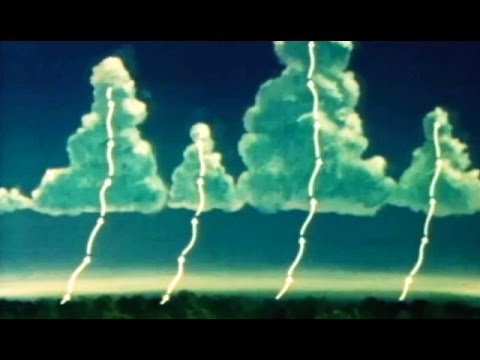More at
“DEVELOPMENT OF THE TEN BASIC TYPES OF CLOUDS, THEIR PRINCIPAL CHARACTERISTICS, THEIR RELATIVE POSITIONS AND AVERAGE ALTITUDES, AND THEIR FLIGHT HAZARDS.”
US Army training film TF46-3724
Reupload of a previously uploaded film, in one piece instead of multiple parts.
Public domain film from the National Archives, slightly cropped to remove uneven edges, with the aspect ratio corrected, and mild video noise reduction applied.
The soundtrack was also processed with volume normalization, noise reduction, clipping reduction, and equalization (the resulting sound, though far from perfect, is far less noisy than the original).
Clouds are classified according to their height above and appearance (texture) from the ground.
The following cloud roots and translations summarize the components of this classification system:
1) Cirro-: curl of hair, high. 3) Strato-: layer. 5) Cumulo-: heap.
2) Alto-: mid. 4) Nimbo-: rain, precipitation.
High-level clouds:
High-level clouds occur above about 20,000 feet and are given the prefix “cirro-“. Due to cold tropospheric temperatures at these levels, the clouds primarily are composed of ice crystals, and often appear thin, streaky, and white (although a low sun angle, e.g., near sunset, can create an array of color on the clouds).
The three main types of high clouds are cirrus, cirrostratus, and cirrocumulus.
Cirrus clouds are wispy, feathery, and composed entirely of ice crystals. They often are the first sign of an approaching warm front or upper-level jet streak.
Unlike cirrus, cirrostratus clouds form more of a widespread, veil-like layer (similar to what stratus clouds do in low levels). When sunlight or moonlight passes through the hexagonal-shaped ice crystals of cirrostratus clouds, the light is dispersed or refracted (similar to light passing through a prism) in such a way that a familiar ring or halo may form. As a warm front approaches, cirrus clouds tend to thicken into cirrostratus, which may, in turn, thicken and lower into altostratus, stratus, and even nimbostratus.
Finally, cirrocumulus clouds are layered clouds permeated with small cumuliform lumpiness. They also may line up in streets or rows of clouds across the sky denoting localized areas of ascent (cloud axes) and descent (cloud-free channels).
Mid-level clouds:
The bases of clouds in the middle level of the troposphere, given the prefix “alto-“, appear between 6,500 and 20,000 feet. Depending on the altitude, time of year, and vertical temperature structure of the troposphere, these clouds may be composed of liquid water droplets, ice crystals, or a combination of the two, including supercooled droplets (i.e., liquid droplets whose temperatures are below freezing).
The two main type of mid-level clouds are altostratus and altocumulus.
Altostratus clouds are “strato” type clouds (see below) that possess a flat and uniform type texture in the mid levels. They frequently indicate the approach of a warm front and may thicken and lower into stratus, then nimbostratus resulting in rain or snow. However, altostratus clouds themselves do not produce significant precipitation at the surface, although sprinkles or occasionally light showers may occur from a thick alto-stratus deck.
Altocumulus clouds exhibit “cumulo” type characteristics (see below) in mid levels, i.e., heap-like clouds with convective elements. Like cirrocumulus, altocumulus may align in rows or streets of clouds, with cloud axes indicating localized areas of ascending, moist air, and clear zones between rows suggesting locally descending, drier air. Altocumulus clouds with some vertical extent may denote the presence of elevated instability, especially in the morning, which could become boundary-layer based and be released into deep convection during the afternoon or evening…

